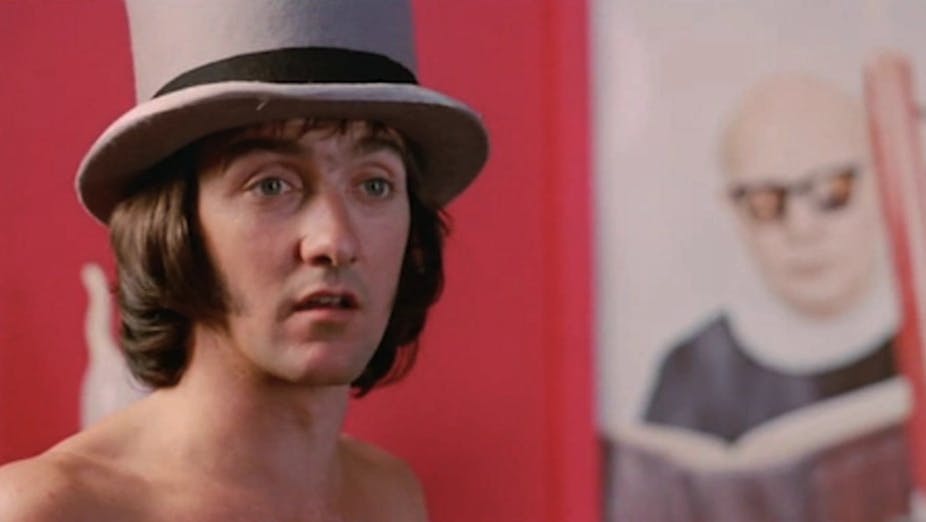Fifty years ago this week, the first blockbuster of the Australian new wave hit Australian cinemas. Directed by Tim Burstall and starring Graeme Blundell, Alvin Purple was a bawdy sex comedy about an unprepossessing young man who was irresistible to women.
It was a hit, screening for months after its release. A sequel, Alvin Rides Again, quickly followed in 1974, and a short-lived television series aired in 1976.
However, the jiggling flesh and bed-hopping antics of Alvin Purple were probably not what Australian politicians had in mind when they devised policies to create a local film industry in the late 1960s.
A wave of new nationalism
In the wake of global political and economic shifts, including the United Kingdom’s decision to join the European Common Market in 1973, Australia undertook a reevaluation of its national identity. Intellectuals and politicians believed culture, and film in particular, could foster this process and promote Australia to the world in an era of “new nationalism”.
The Holt and Gorton Liberal governments established the Australian Council for the Arts in 1967 and the Australian Film Development Corporation (AFDC) in 1970.
This embrace of government support for the arts was new. Government funding expanded the national significance and box office reach of Australian cinema. The Australian Film Development Corporation was encouraged to back popular, rather than arthouse films, with the aim of growing a commercially viable film industry.
The impact of this investment was quickly felt: while just 17 feature films were made in Australia in the 1960s, more than 150 were made in the 1970s.
Alvin Purple was the first big hit of this new era in Australian film, a standard-bearer of the new nationalism. As with so many images of Australian identity, such as the Anzac and the bushman, the new nationalism was represented by a white bloke: in this case, the Ocker. The Ocker was keen on colourful language, beer and women, in that order.
The Ocker was crucial to the new film industry, just as he had been the new radical Australian theatre of the late 1960s. Many of those involved in theatre would go on to shape Australian film, including Burstall and Blundell.
Australia’s new cinema classification system – which replaced the older system of strict censorship – was the second key ingredient in Australian cinema’s new wave. The Ocker films were almost all bawdy comedies which took advantage of the new R rating for films introduced in 1971. Alvin Purple’s abundant nudity – what one reviewer described as “boobs and pubes” – was one of the reasons it became a hit.
Read more: Paul Hogan and the myth of the white Aussie bloke
An Aussie sex comedy
In making Alvin Purple, Tim Burstall wanted to create “a sex comedy with […] purely Australian ingredients”.
Alvin Purple is indeed an Australian sex comedy but the joke is on Alvin: despite his view sex is “overrated”, he is bewilderingly irresistible to women of all ages, from screaming schoolgirls to the wife of his school principal, to the psychologist he sees in a bid to avoid sex.
To a generation of Australians raised on The Benny Hill Show (as I was), Alvin Purple looks like just another 70s sex comedy. It was as unpopular with critics as it was a hit with Australian audiences. But dig a little deeper and we can see how the film not only responded to the rise of the women’s movement, but also how it became a touchstone for feminists who were outraged by Australia’s sexist culture.
The central conceit of Alvin Purple – that he is an average bloke who is utterly irresistible to women – was an appealing male fantasy in an era of sexual liberation. Almost every female character in the film wants to have sex with Alvin. Director Burstall admitted to Cleo magazine in 1975 that Alvin Purple was a fantasy, “and if you want to get heavy, a male chauvinist fantasy”.
In the film’s opening scene, Alvin is riding a tram and, looking around at the alluringly dressed female passengers, complains:
How can you keep your mind off [sex] when it’s being flung at you every moment of the day?
Indeed, the women around him seem to invite his objectifying gaze: one woman wears a t-shirt reading “women should be obscene and not heard”, and Alvin fantasises about ripping another woman’s shirt open to expose her bare breasts. The film conflated the sexual revolution with women’s liberation.
For some Australian feminists, Alvin Purple was a symbol of Australian sexism. In 1974, two feminist protesters picketed the set of Burstall’s next film with placards reading “smash sexist movies” and “Burstall sexist shit”.
Sandra Hall, reviewing the film for The Bulletin described it as
cheerfully sexist […] there is flesh everywhere but the motivations are made of cardboard and the women are universally stupid.
In spite of, or perhaps because of this, Alvin Purple remains one of Australia’s highest-grossing films of all time. It is one of only three films made in the 1970s to make it into Screen Australia’s list of 100 top grossing local films.
Alvin Purple demonstrated Australians were ready to embrace local stories on their cinema screens. But the film’s legacy is complicated by its thin and stereotypical representation of women.
We cannot simply write the film’s sexism off as a product of a different time when women were criticising it for that very reason when it was released. Alvin still placed men at the centre of Australian stories, and that’s something we’re still wrestling with, 50 years on.
Read more: Don’s Party at 50: an achingly real portrayal of the hapless Australian middle-class voter

